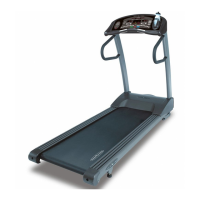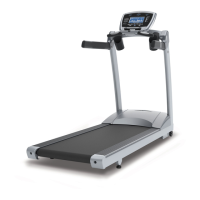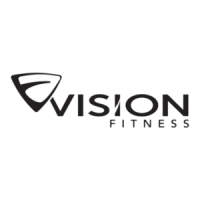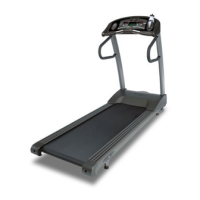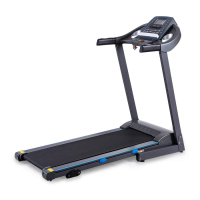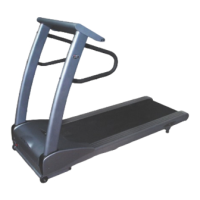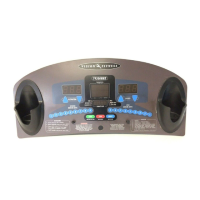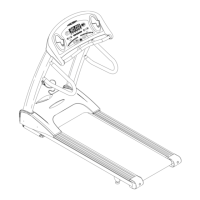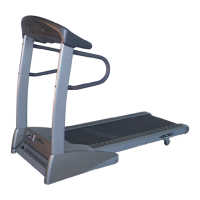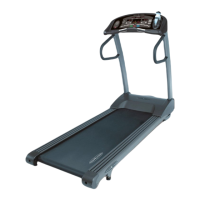
Do you have a question about the Vision Fitness T9700 Simple and is the answer not in the manual?
| Motor | 3.0 hp |
|---|---|
| Running Area | 20" x 60" |
| Incline Range | 0-15% |
| Speed Range | 0.5-12 mph |
| Belt | 2-ply |
Essential precautions for safe operation and preventing injury.
Guidelines for keeping children and pets safe around the treadmill.
Details about voltage, plug type, and circuit requirements for the treadmill.
Advice on what to do if experiencing discomfort during exercise.
Guidance on how to clean the treadmill using mild soap and water.
Instructions on how to safely move the treadmill using transport wheels.
Recommendations for positioning the treadmill in your home for optimal use.
Steps to ensure the treadmill is level for proper operation and belt tracking.
How to connect to power and use the main power switch.
How to use the emergency stop button for immediate halt.
Using the safety magnet to start and stop the treadmill.
Explains the scrolling instructions and feedback displayed on the console.
Definitions for Distance, Avg Pace, Heart Rate, % Heart Rate, and Time.
How incline, calories, and speed are shown on the console.
Explanation of how average speed is calculated and displayed.
Describes the orange dots representing elevation segments.
Describes the red dots representing speed segments.
Explanation of the SPB that shows accumulated time per segment.
How to use the SELECT button to cycle through workout data.
How to log in with a user ID to save workout data.
How to choose programs using quick keys or manual mode.
How to view accumulated workout data for a user.
Procedure to clear saved user total information.
Using numbered keys to adjust speed instantly.
Using numbered keys to adjust incline instantly.
How to use built-in sensors to monitor heart rate.
Information about the port for entertainment system connectivity.
How to moisten the contact pads before wearing the transmitter.
Guidance on correctly positioning the transmitter strap on the body.
How to begin a workout with the Easy Start function.
Setting age to determine predicted maximum heart rate.
How to choose and set the duration of the workout.
Inputting weight to adjust calorie calculations.
Using quick keys to select programs like SPRINT 8, HRT, or USER.
How to choose a specific program within categories.
Setting age for accurate heart rate calculations in HRT programs.
How to choose the intensity level for programs.
Explanation of the 10 levels for most programs and 17 for SPRINT 8.
How to select and enter the desired workout duration.
Inputting weight to adjust calorie calculations.
Details of the anaerobic interval program for muscle and speed improvement.
Customizable workouts with no default time setting.
Program to improve strength, speed, and endurance via elevation changes.
Program for weight loss using speed variations within the fat burning zone.
Program to improve cardiovascular training by simulating a 5K run with hills.
Program promoting fat burning through speed and elevation adjustments.
Motivational program to race against the console for distance.
Details on the anaerobic interval program for muscle and speed.
Explanation of the Warm-up, Interval Training, and Cool-down phases.
Motivational program to race against the console.
How to select a consistent speed for the pacer.
How to set the goal distance for the race against the pacer.
Inputting weight to adjust calorie calculations.
How to begin the workout once settings are configured.
Program to maintain 65% of max heart rate for weight loss.
Program to maintain 80% of max heart rate for cardiovascular benefits.
How to select between HRT Weight Loss and HRT Cardio.
Setting age for accurate heart rate calculations.
How to input the desired target heart rate for the program.
How to select and confirm the workout duration.
How to enter weight to improve calorie tracking accuracy.
User-controlled warm-up to reach target heart rate zone.
Automatic adjustment of speed and elevation to maintain target zone.
Manual mode for cooling down at the user's own pace.
How to stop the treadmill after the cool-down phase.
Important information regarding heart rate detection and console behavior.
Program designed to maintain target heart rate through speed/elevation adjustments.
Steps to select the HRT Endurance program.
Setting age for accurate heart rate calculations.
How to input the desired target heart rate for the program.
How to select and confirm the workout duration.
Inputting weight to adjust calorie calculations.
User-controlled warm-up to reach 85% of target heart rate.
Automatic speed and elevation adjustment to maintain target zone.
Manual mode for cooling down at the user's own pace.
How to stop the treadmill after the cool-down phase.
Important information regarding heart rate detection and console behavior.
Program focusing on intervals at 95-100% of target heart rate.
Steps to select the HRT Interval program.
Setting age for accurate heart rate calculations.
How to input the desired target heart rate for the program.
How to select and confirm the workout duration.
How to enter weight to improve calorie tracking accuracy.
User-controlled warm-up to reach 85% of target heart rate.
Automatic speed adjustment for recovery and work intervals.
Manual mode for cooling down at the user's own pace.
How to stop the treadmill after the cool-down phase.
Important information regarding heart rate detection and console behavior.
Steps to create custom workout programs with 20 intervals.
Setting age for predicted maximum heart rate calculation.
How to set and save the total workout time.
How to store speed and elevation for each segment.
How to start exercising with a programmed custom workout.
How to choose User Program 4 or 5 to save workouts.
How to begin exercising after setting up a User Learn program.
Procedure to save recorded workout data to a User Learn program.
How to access and run a previously saved User Learn program.
How to overwrite an existing User Learn program with new data.
How to enter the mode by holding SPEED DOWN and SELECT.
Setting units to English (miles/mph) or Metric (km/kph).
Modifying the maximum time setting for the treadmill.
Setting the default weight for calorie calculations.
Viewing accumulated time data, which cannot be modified.
Viewing accumulated distance data, which cannot be modified.
Modifying the pause time duration from 20 seconds to 10 minutes.
Modifying the default workout time from 10-99 minutes.
Modifying the default age, which is set to 40.
Procedure to clear elevation errors and operate without elevation.
Changing the text speed for the alphanumeric display (1-5).
Enabling/disabling the deck lubrication service reminder.
Enabling/disabling the treadmill cleaning service reminder.
Enabling/disabling the motor brushes check service reminder.
Steps to run automatic calibration without standing on the belt.
Procedure to exit the engineering mode and reboot the console.
Solutions for when the console does not light up or breaker trips.
Troubleshooting treadmill shutting off when elevated.
Solutions for belt not staying centered or moving within rails.
Solutions for no pulse reading from the chest strap.
Troubleshooting an inconsistent pulse reading.
Reasons why heart rate monitors may not function properly.
Explanation of typical noises the treadmill makes during operation.
Reasons why a treadmill might sound louder at home than in a store.
Guidance on identifying abnormal or concerning treadmill noises.
How to adjust belt tension if it slips during use.
Procedure to adjust belt position if it drifts to the side.
Information on contacting the local dealer for warranty details.
Explanation of how warm-up prepares muscles and increases blood flow.
How a gradual warm-up improves muscle function and prevents injury.
Advice on safe and effective stretching techniques.
Instructions for performing a hamstring and calf stretch.
How to stretch the quadriceps muscle for flexibility.
Instructions for stretching the calf muscles.
Guidelines for frequency, warm-up, duration, and cool-down for aerobic exercise.
Specific recommendation for aerobic activity duration for weight loss.
Importance of setting and defining personal fitness goals.
How console readouts help in tracking progress towards goals.
Examples of setting and measuring fitness goals.
Using log sheets to track personal exercise progress.
Template for recording daily workouts, goals, and rewards for a week.
Monthly log sections to track minutes and distance for the first six months.
Monthly log sections to track minutes and distance for the last six months.
